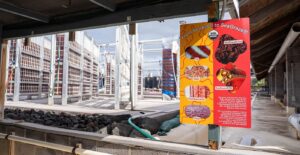There’s a lot of talk, but rather less action on regenerative agriculture from some publicly listed agrifood companies, according to a new report from investor network FAIRR.
Two thirds of publicly-listed agrifood companies that have talked publicly about the potential of regenerative agriculture “have not put in place any formal quantitative company-wide targets to achieve those ambitions,” according to FAIRR.
There is no universally accepted definition of regenerative agriculture, but initiatives typically focus on carbon removal or sequestration, soil health (soil organic matter, water-holding capacity, micro/macronutrients), biodiversity, watershed health (more efficient use of water and reducing pollution), and farmer livelihoods.
‘Investors will want to see measurable targets’
In a study of 79 publicly-listed agri-food firms by FAIRR, 50 have talked publicly about the benefits of regenerative agriculture. However, 32 of these 50 have not set formal targets.
Even fewer (4/50) have committed funds to incentivize farmers to take up regenerative practices, with notable exceptions including Nestlé, PepsiCo, JBS, and Sodexo, says FAIRR’s director of thematic research and corporate innovation Jo Raven: “Without adequate support for farmers, there can be no successful regenerative agriculture.”
She added: “Transitioning away from conventional practices towards regenerative practices creates risk for farmers as it will likely require significant upfront investment, such as new machinery, agronomic support and experimentation, and could impact short-term productivity for farms.
“FAIRR’s research shows there are more promises than progress in the agri-food sector,” added chair and founder Jeremy Coller.” Investors will want to see measurable targets that match companies’ stated ambitions on regenerative agriculture if they are to ensure they don’t fall foul of anti-greenwash regulations.”
FAIRR: Without an agreed definition, it’s impossible to measure progress or hold companies to account
Part of the problem when it comes to holding companies to account, according to Coller, is that there is no internationally agreed definition of regenerative agriculture, which “makes claims hard to substantiate, creating significant risk in terms of incoming regulation and changing reporting frameworks.”
He added: “Multinational food giants have filled endless press releases with talk of their commitment to regenerative agriculture, but with no agreed definition of the term it’s impossible to measure what progress they’re making or hold them to account for failing to keep their promises.”
While most practitioners agree that being overly prescriptive about what constitutes regenerative practices is unhelpful, it is possible to look at outcomes, from carbon sequestration and agrochemical use to soil health, says FAIRR.
“Only 24% of the 50 companies discussing regenerative agriculture in public reporting had any alignment between regenerative agriculture and Scope 3 targets. And only 8% are looking to quantify the contribution of regenerative agriculture initiatives to their Scope 3 targets. Given that regenerative strategies are marketed as a scalable climate solution, this lack of alignment is problematic.”
The report adds: “Only a few companies are beginning to make the connection between regenerative agriculture with climate targets.”
Mars and PepsiCo: No one size fits all definition of regenerative ag
While ‘regenerative’ is now the buzzword of choice in food marketing, more data is needed to define what it means for individual crops before growers can see a clear business case for adopting new practices, according to Mars, a privately held company not included in FAIRR’s analysis.
“It might even be different within the same crop grown in different places,” said Caitlin Birkholz, regenerative agriculture pillar lead at KIND Snacks (part of Mars), who spoke to AgFunderNews earlier this year. “So Northern California is different to Southern California, and the yields can be radically different,” added Birkholz, who recently unveiled plans to test regenerative practices on 500 acres of almonds in California over the next three years.
As for incentivizing farmers, she added: “As regenerative agriculture can take 3+ years to show meaningful soil health changes, it can be hard to go to a grower and say, ‘Hey, can you adopt cover crops that you’re going to mow down in a couple of months for some unknown soil health benefit in the future?’ That can be a hard conversation to have.
“So that’s why we have a pilot that shows what that journey looks like, that will outline some of the challenges we encounter and how we overcame them. So if one grower says, ‘Hey, I tried this thing and it didn’t work for me,’ we can share these learnings and give growers more detailed, nuanced information. This helped me reduce pesticides, this helped me cut down on fertilizer costs.”
As for labeling, KIND Snacks has no immediate plans to make claims such as such as “regeneratively farmed” on its snacks, added Liz Jacobsen, global technical sustainability director at Mars.
“In terms of on-pack claims, we don’t have plans to put ‘made with regenerative ag’ on labels just yet, in part because there’s no clear definition yet. We also don’t know what that would mean legally in terms of substantiation.”
Regenerative… the new natural?
But if other companies are not as circumspect, could ‘regenerative’ risk becoming the new ‘natural’—the most meaningless word in food marketing—if there are not more consistent and rigorous definitions?
“It’s definitely a risk,” Margaret Henry, senior director, sustainable agriculture strategy and external engagement at PepsiCo, told us in a recent interview, adding that PepsiCo is focused on outcomes rather than being super-prescriptive about how farmers deploy regenerative ag tools.
“This is why we’re focusing on outcomes, measurable improvements in five areas: Carbon, soil health, biodiversity, watershed health, and farmer livelihoods. We’re not going to be prescriptive, we’re agnostic on practices and we’re not taking a position on particular technologies.”
PepsiCo, which is pumping $216 million into regenerative agriculture projects spanning 3 million acres of farmland in the US, says money will be allocated to a variety of projects, from upfront cash to farmers to cover the cost of seeds for cover crops, to education projects.
“The vast majority of the money will go directly to farmers, whether it’s to cover upfront costs, or through outcomes-based payments, where you get money depending on how much carbon you sequester, how much water quality improves and so on,” said Henry.
Ultimately, she said, the aim is that projects become self-sustaining.
The incoming EU Green Claims Directive, due to come into force in 2026, will put an onus on any food company marketing in the EU to substantiate environmental claims, with the penalty for non-compliance reaching up to 4% of annual sales. New guidance from the Advertising Standards Authority in the UK also stipulates that sustainability claims must be fully verifiable and substantiated, notes FAIRR.
According to FAIRR’s research, ‘soil health’ and ‘carbon-related’ outcomes were the two most cited sustainability outcomes cited by companies covered in its analysis. These were followed by ‘improving water use and quality’, ‘biodiversity’ and ‘reduced use of agrochemicals.’
Examples of regenerative agriculture commitments include:
- Danone has committed to sourcing 30% of key ingredients from farms transitioning to regenerative agriculture by 2025
- General Mills is to implement regenerative agriculture practices on 1 million acres of farmland by 2030
- Walmart, through a collaboration with PepsiCo, has set a target to eliminate 4 million tons of greenhouse gas emissions through its regenerative agriculture program.
- Nestlé has committed to source 20% of its key ingredients through regenerative agriculture by 2025 and 50% by 2030.
- Mondelēz International has committed to produce 100% of wheat for through regenerative agriculture by 2030




